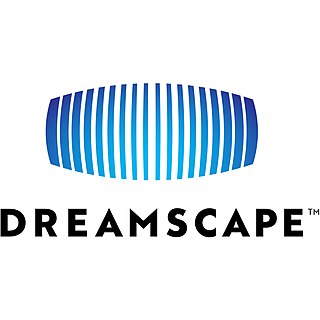Related Research Articles

Virtual reality (VR) is a simulated experience that employs pose tracking and 3D near-eye displays to give the user an immersive feel of a virtual world. Applications of virtual reality include entertainment, education and business. Other distinct types of VR-style technology include augmented reality and mixed reality, sometimes referred to as extended reality or XR, although definitions are currently changing due to the nascence of the industry.

Windows Mixed Reality is a platform introduced as part of the Windows 10 and 11 operating system, which provides augmented reality and virtual reality experiences with compatible head-mounted displays.

VIVE, sometimes referred to as HTC Vive, is a virtual reality brand of HTC Corporation. It consists of hardware like its titular virtual reality headsets and accessories, virtual reality software and services, and initiatives that promote applications of virtual reality in sectors like business, arts, and video gaming.
WebXR Device API is a Web application programming interface (API) that describes support for accessing augmented reality and virtual reality devices, such as the HTC Vive, Oculus Rift, Oculus Quest, Google Cardboard, HoloLens, Magic Leap or Open Source Virtual Reality (OSVR), in a web browser. The WebXR Device API and related APIs are standards defined by W3C groups, the Immersive Web Community Group and Immersive Web Working Group. While the Community Group works on the proposals in the incubation period, the Working Group defines the final web specifications to be implemented by the browsers.
OpenVR is a software development kit (SDK) and application programming interface (API) developed by Valve for supporting the SteamVR and other virtual reality headset devices. The SteamVR platform uses it as the default application programming interface and runtime. It serves as the interface between the virtual reality hardware and software and is implemented by SteamVR.

A virtual reality headset is a head-mounted device that provides virtual reality for the wearer. VR headsets are widely used with VR video games but they are also used in other applications, including simulators and trainers. VR headsets typically include a stereoscopic display, stereo sound, and sensors like accelerometers and gyroscopes for tracking the pose of the user's head to match the orientation of the virtual camera with the user's eye positions in the real world.
Fantastic Contraption is a room scale virtual reality video game for the HTC Vive and PlayStation VR in which players construct machines from building materials to meet challenges. It was released at the HTC Vive's launch on April 5, 2016 and was released for PlayStation VR in July 2017.
Tilt Brush is a room-scale 3D-painting virtual-reality application available from Google, originally developed by Skillman & Hackett.

Daydream is a discontinued virtual reality (VR) platform which was developed by Google, primarily for use with a headset into which a smartphone is inserted. It is available for select phones running the Android mobile operating system that meet the platform's software and hardware requirements. Daydream was announced at the Google I/O developer conference in May 2016, and the first headset, the Daydream View, was released on November 10, 2016. To use the platform, users place their phone into the back of a headset, run Daydream-compatible mobile apps, and view content through the viewer's lenses.
Survios is an American virtual reality game developer and software publisher based in Los Angeles, California. The company develops virtual reality software and games, including the titles Raw Data and Sprint Vector. Survios was created by graduates from the University of Southern California's Mixed Reality Lab, where they worked together on Project Holodeck. The company has raised over $54 million in venture funding led by Shasta Ventures, Lux Capital and Metro-Goldwyn-Mayer.
Foveated rendering is a rendering technique which uses an eye tracker integrated with a virtual reality headset to reduce the rendering workload by greatly reducing the image quality in the peripheral vision.
OpenXR is an open-source, royalty-free standard for access to virtual reality and augmented reality platforms and devices. It is developed by a working group managed by the Khronos Group consortium. OpenXR was announced by the Khronos Group on February 27, 2017, during GDC 2017. A provisional version of the standard was released on March 18, 2019, to enable developers and implementers to provide feedback on it. On July 29, 2019, OpenXR 1.0 was released to the public by Khronos Group at SIGGRAPH 2019.
The Hyper Reality Experience is a mixed reality, multi-player game experience, which opened to the public in Leeds, England on 22 April 2017. It utilises a combination of virtual reality, motion tracking, haptic feedback and theatrical special effects to create an immersive experience where players can interact as a team within a virtual environment, with other senses such as touch provided by a specially designed physical space and props the player can feel and utilise.

Dreamscape Immersive is an American entertainment and technology company. It creates story-based full-roam virtual reality (VR) experiences which allow up to six people to simultaneously explore a virtual 3D environment, seeing fully rendered avatars of one another. Using real-time motion capture technology, full body mapping, virtual reality headsets, and real-life room-scale stage sets, it enables users to move untethered in a virtual environment and interact with physical objects. The technology was created by Caecilia Charbonnier and Sylvain Chagué, and developed by engineers at Artanim, a Swiss research center specialized in motion-capture technologies.

A virtual reality game or VR games is a video game played on virtual reality (VR) hardware. Most VR games are based on player immersion, typically through head-mounted display unit or headset with stereoscopic displays and one or more controllers.

Virtual reality applications are applications that make use of virtual reality (VR), an immersive sensory experience that digitally simulates a virtual environment. Applications have been developed in a variety of domains, such as education, architectural and urban design, digital marketing and activism, engineering and robotics, entertainment, virtual communities, fine arts, healthcare and clinical therapies, heritage and archaeology, occupational safety, social science and psychology.
The Valve Index is a consumer virtual reality headset created and manufactured by Valve. Announced on April 30, 2019, the headset was released on June 28 of the same year. The Index is a second-generation headset and the first to be manufactured completely by Valve. Half-Life: Alyx is bundled in with the headset.
Viverse is an open platform for virtual worlds and environments developed by HTC and encompassing multiple devices and applications. Conceived as a metaverse, the platform is intended to create an interconnected series of virtual worlds, and includes elements of augmented reality. The Viverse platform consists of various components, including virtual reality headsets, social applications, and content creation tools.

Crisis on the Planet of the Apes VR is a 2018 action and virtual reality game. It was developed by Imaginati and published by FoxNext for PlayStation 4 and Microsoft Windows. It is based on the Planet of the Apes reboot film series, taking place between Rise of the Planet of the Apes and Dawn of the Planet of the Apes.
References
- 1 2 Verrier, Richard (November 12, 2011). "Exploring the ocean in a new interactive medium". Los Angeles Times. Retrieved February 8, 2021.
- 1 2 Feltham, Jamie (March 2, 2015). "WEVR Bringing TheBluVR: Encounter To HTC Vive". VRFocus. Retrieved February 8, 2021.
- ↑ Schaefer, Samantha (November 24, 2011). "Diving into a digital ocean — literally". Southern California Public Radio. Retrieved February 8, 2021.
- ↑ Volpe, J. (February 19, 2016). "Wevr: The virtual reality studio you need to know". Engadget. Retrieved February 8, 2021.
- ↑ Watercutter, Angela (May 4, 2012). "Virtual Ocean theBlu Takes Social Interaction to New Depths". Wired. Retrieved February 8, 2021.
- ↑ "Write a Love Letter to the Ocean, Get Your Tweet Shown in Times Square". National Geographic Society Newsroom. 2012-05-03. Retrieved 2021-04-05.
- ↑ Stark, Leigh D. (February 18, 2015). "A future on your face: Samsung's Gear VR reviewed". Gadget Guy. Retrieved February 8, 2021.
- ↑ Giardina, Carolyn (September 22, 2015). "Virtual Reality Spy Game 'I Expect You To Die' Tops Second Annual Proto Awards". The Hollywood Reporter. Retrieved February 8, 2021.
- ↑ Brewster, Signe (March 7, 2015). "Hands on with the HTC Valve Vive virtual reality headset". GigaOM. Retrieved February 8, 2021.
- ↑ "Sundance Institute Celebrates New Frontier 10th Anniversary at 2016 Festival". www.sundance.org. December 3, 2015. Retrieved 2021-04-06.
- ↑ Volpe, J. (April 5, 2016). "Got an HTC Vive? Now's your chance to swim with a blue whale". Engadget. Retrieved February 8, 2021.
- ↑ Giardina, Carolyn (October 8, 2016). "Proto Virtual Reality Awards Winners Revealed". The Hollywood Reporter. Retrieved February 8, 2021.
- ↑ "L.A.'s Natural History Museum Takes Virtual Reality Plunge Into 'theBlu'". The Hollywood Reporter. 2017-03-03. Retrieved 2021-04-05.
- ↑ Roettgers, Janko (November 28, 2018). "AMC-Backed VR Startup Dreamscape Immersive Opens Los Angeles Location". Variety. Retrieved February 8, 2021.
- ↑ Roettgers, Janko (December 14, 2018). "How Wevr & Dreamscape Immersive Reinvented 'The Blu' for Location-Based VR". Variety. Retrieved February 8, 2021.
- ↑ "Sylvia Earle 'Delighted' To Join Board Of Advisors Of Ocean-Themed Web Media Property Theblu.com". Mission Blue. 2011-12-08. Retrieved 2021-12-10.
- ↑ "What's Big, Blue, Hopes To Save Our Planet And Is Not Facebook?". TechCrunch. Retrieved 2021-12-10.
- ↑ Colloca, Luana; Raghuraman, Nandini; Wang, Yang; Akintola, Titilola; Brawn-Cinani, Barbara; Colloca, GianCarlo; Kier, Craig; Varshney, Amitabh; Murthi, Sarah (2020-09-01). "Virtual reality: physiological and behavioral mechanisms to increase individual pain tolerance limits". Pain. 161 (9): 2010–2021. doi:10.1097/j.pain.0000000000001900. ISSN 1872-6623. PMC 7584744 . PMID 32345915.
- ↑ "Scientists are unraveling the mysteries of pain". Magazine. 2019-12-17. Retrieved 2021-12-10.